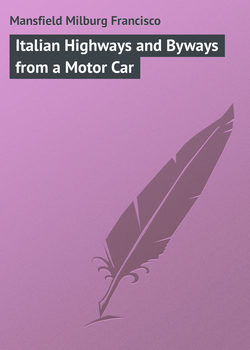Читать книгу Italian Highways and Byways from a Motor Car - Mansfield Milburg Francisco - Страница 5
CHAPTER V
IN LIGURIA
ОглавлениеTHE most ravishingly beautiful entrance into Italy is by the road along the Mediterranean shore. The French Riviera and its gilded pleasures, its great hotels, its chic resorts and its entrancing combination of seascape and landscape are known to all classes of travellers, but at Menton, almost on the frontier, one is within arm’s reach of things Italian, where life is less feverish, in strong contrast to the French atmosphere which envelops everything to the west of the great white triangle painted on the cliff above the Pont Saint Louis and marking the boundary between the two great Latin countries.
The “Route Internationale,” leading from France to Italy, crosses a deep ravine by the Pont Saint Louis with the railway running close beside.
Not so very long ago there was a unity of speech and manners among the inhabitants of Menton and the neighbouring Italian towns of Grimaldi, Mortola and Ventimiglia, but little by little the Ravine of Saint Louis has become a hostile frontier, where the custom house officials of France and Italy regard each other, if not as enemies, at least as aliens. The two peoples are, however, of the same race and have the same historic traditions.
It was just here, on passing the frontier, that we asked a deep-eyed, sun-burnt young girl of eighteen or twenty if she was an Italian, thinking perhaps she might be a Niçoise, who, among the world’s beautiful women, occupy a very high place. She replied in French-Italian: “Oui, aussi bien Venitienne!” This was strange, for most Venetians, since Titian set the style for them, have been blondes.
A château of the Grimaldi family crowns the porphyry height just to the eastward of the Italian frontier, and below is the Italian Dogana, where the automobilist and other travellers by road go through the formalities made necessary by governmental red tape. Red tape is all right in the right place, but it should be cut off in proper lengths, so that officials need not be obliged to quibble over a few soldi while individuals lose a dozen francs or more in valuable time.
This matter of customs formalities at Grimaldi is only an incident. The automobilist’s troubles really commence at a little shack in Menton, on French soil, just before the Pont Saint Louis is crossed. Here he has his “passavant” made out, an official taking a lot of valuable time to decide whether the cushions of your automobile are red, orange or brown. You stick out for orange because they were that colour when you bought the outfit, but the representative of the law sticks out too – he for red. The result is, you compromise on brown, and hope that the other customs guardian on duty at the frontier post by which you will enter France again will be blessed with the same sense of colour-blindness as was his fellow of Menton. Once this formality gone through – and you pay only two sous for the documents – you have no trouble getting back into France again by whichever frontier town you pass. There are no duties to pay and no disputes, so really one cannot complain. It is for his benefit anyway that the “passavant” describing the peculiarities of automobile is issued.
At the Grimaldi Dogana on entering Italy you are made to pay duty on what little gasoline you may have in your tanks, even for as little as a litre. Presumably you pass your machine through the Italian customs with one of the “triptyches” issued by any of the great automobile clubs or touring associations, as otherwise you have to put down gold, and a thousand or fifteen hundred francs in gold one does not usually carry around loose in his pocket. We passed through readily enough, but a poor non-French, non-Italian speaking American who followed in our wheel-tracks had not made his preparations beforehand, and French banknotes didn’t look good enough to the Italian customs official, and a day was lost accordingly while the poor unfortunate rolled back down hill to Menton and sought to turn the notes into gold. The banks having just closed he was not able to do this as readily as he thought he might, and it was well on after sunrise that he followed our trail – and never caught up with us all the way to Grosetto.
Mortola is the first town of note that one passes on entering Italian soil, but beyond its aspect, so alien to that of the small town in France, it is not worthy of remark.
Ventimiglia comes next, where the traveller by rail goes through equally annoying customs formalities to those experienced by the traveller by road at Grimaldi. These are not apt to be so costly, as the customs officials take him at his word, graciously chalk his luggage and pass him on. The Guardie-Finanze, or customs officer, of Italy is a genteel looking young person with a bowler hat, topped with a feather cockade. He is even as gay and picturesque as the “carabinieri reales,” though he is a mere plebeian among the noblesse of soldierdom.
The Vintimille of the French, or the Ventimiglia of the Italians, was the ancient Intemilium of the Romans. To-day, on the left bank of the Roja, is a new city made up of the attributes of a great railway and frontier station and a numerous assemblage of alberghi, hotels, restaurants and the like.
Ventimiglia is not unlovely, neither is it lovely in a picturesque romantic sense. Its site is charming, on the banks of the tumbling Roja at the base of the Alps of Piedmont, just where they plunge, from a height of a thousand or twelve hundred metres, down into the lapping Mediterranean waves.
